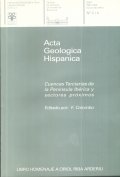Una propuesta de clasificación de las cuencas neógenas béticas
Abstract
There are numerous neogene basins in the Betic Cordillera (Southern Spain), with a thick sedimentary infill constituted by Miocene, Pliocene and/or Pleistocene materials, in which important stratigraphical differences can be detected. During the Neogene the Betic Cordillera adquired its present configuration and the formation, evolution and total or partial destruction of the Neogene sedimentary basins were highly controlled by the geodynamic situations and the position of the basins in it. We proposed a classification dividing the Betic Neogene Basins in two groups, according to the two main different geodynamic situations existing in the Betic Cordillera in this interval of time. The first group corresponds to the basins formed during the Early and Middle Miocene, coetaneously with the westward drift of the Internal Zones. It is impossible to establish a complete classification of the basins formed during this time, because in many cases only small outcrops remain. The basins formed in the Internal Zones may be considered as back-arc and intrachain basins. In the External Zones, former South Iberian Margin appeared the foreland basin (the North Betic Strait) with an active sector (foredeep), located in front of the new formed reliefs, that received huge olistostromic masses. This foredeep evolved differently in its eastern and western sectors. The second group of basins is constituted by those formed from the Tortonian onward, when the westward drift of the Internal Zones stopped. With the exception of the already existing foreland basin, the basins formed from the Tortonian onwards, are intramontane basins, which can be subdivided according to the different movements of the fault sets that controlled their evolution. The foreland basin (Guadalquivir Basin), located between the Betic Chain and the emerged Iberian Massif, acquired a structure similar to that of the present basin and its extension was also similar to that of the present Neogene outcrops.


